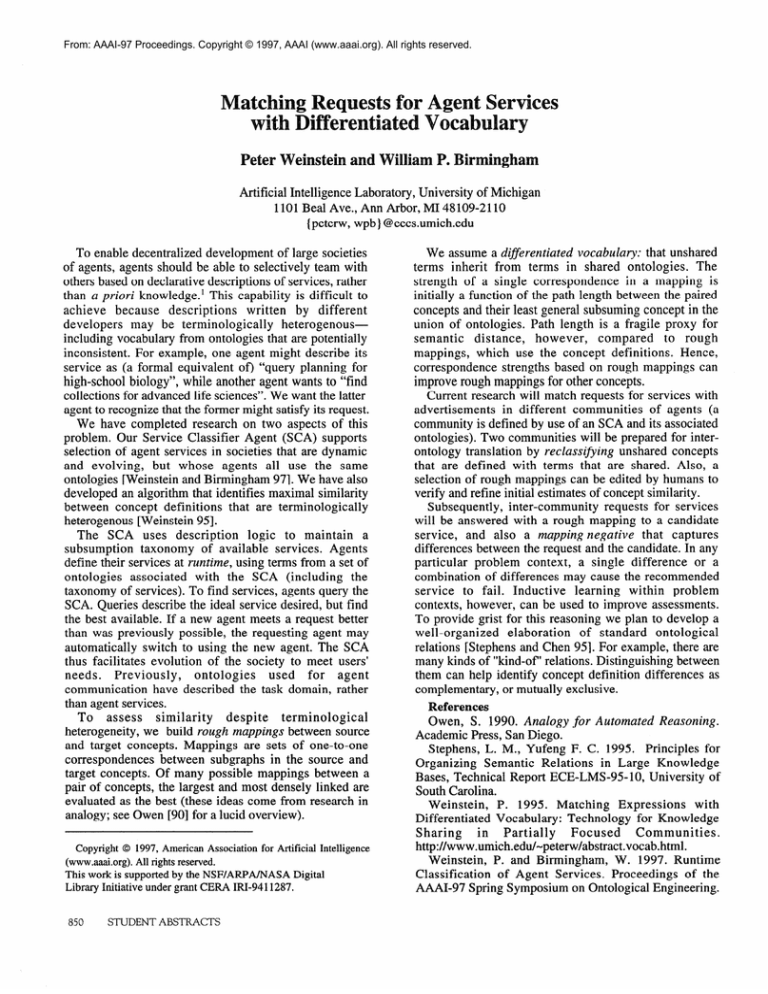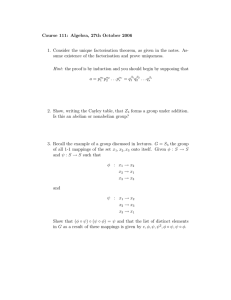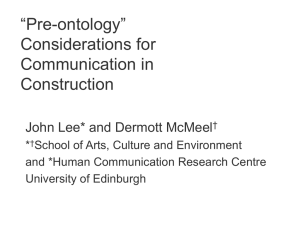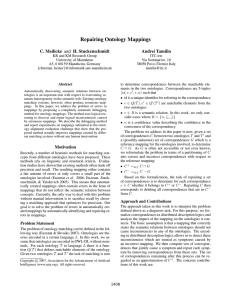
From: AAAI-97 Proceedings. Copyright © 1997, AAAI (www.aaai.org). All rights reserved.
Artificial Intelligence Laboratory, University of Michigan
1101 Beal Ave., Ann Arbor, MI 48109-2110
{peterw, wpb} @eecs.umich.edu
To enable decentralized development of large societies
of agents, agents should be able to selectively team with
others based on declarative descriptions of services, rather
than a priori knowledge.’ This capability is difficult to
achieve
because
descriptions
written
by different
developers
may be terminologically
heterogenousincluding vocabulary from ontologies that are potentially
inconsistent.
For example, one agent might describe its
service as (a formal equivalent of) “query planning for
high-school biology”, while another agent wants to “find
collections for advanced life sciences”. We want the latter
agent to recognize that the former might satisfy its request.
We have completed research on two aspects of this
problem. Our Service Classifier Agent (SCA) supports
selection of agent services in societies that are dynamic
but whose agents all use the same
and evolving,
ontologies [Weinstein and Birmingham 971. We have also
developed an algorithm that identifies maximal similarity
between concept definitions
that are terminologically
heterogenous [Weinstein 951.
The SCA uses description
logic to maintain
a
subsumption
taxonomy
of available
services. Agents
define their services at runtime, using terms from a set of
ontologies
associated
with the SCA (including
the
taxonomy of services). To find services, agents query the
SCA. Queries describe the ideal service desired, but find
the best available. If a new agent meets a request better
than was previously possible, the requesting agent may
automatically
switch to using the new agent. The SCA
thus facilitates evolution of the society to meet users’
Previously,
ontologies
used
for
agent
needs.
communication
have described the task domain, rather
than agent services.
To assess
similarity
despite
terminological
heterogeneity, we build rough mappings between source
and target concepts. Mappings are sets of one-to-one
correspondences
between subgraphs in the source and
target concepts. Of many possible mappings between a
pair of concepts, the largest and most densely linked are
evaluated as the best (these ideas come from research in
analogy; see Owen [90] for a lucid overview).
Copyright
0 1997, American
Association
for Artificial
(www.aaai.org). All rights reserved.
This work is supported by the NSF/ARPA/NASA
Digital
Library Initiative under grant CERA IRI-94 11287.
850
STUDENT ABSTRACTS
Intelligence
We assume a diferentiated
vocabulary: that unshared
terms inherit from terms in shared ontologies.
The
strength of a single correspondence
in a mapping is
initially a function of the path length between the paired
concepts and their least general subsuming concept in the
union of ontologies. Path length is a fragile proxy for
semantic
distance,
however,
compared
to rough
mappings,
which use the concept definitions
Hence,
correspondence
strengths based on rough mappings can
improve rough mappings for other concepts.
Current research will match requests for services with
advertisements
in different communities
of agents (a
community is defined by use of an SCA and its associated
ontologies). Two communities will be prepared for interontology translation by reclassifying
unshared concepts
that are defined with terms that are shared. Also, a
selection of rough mappings can be edited by humans to
verify and refine initial estimates of concept similarity.
Subsequently,
inter-community
requests for services
will be answered with a rough mapping to a candidate
service,
and also a mapping negative
that captures
differences between the request and the candidate. In any
particular
problem context, a single difference
or a
combination
of differences may cause the recommended
service to fail. Inductive
learning
within problem
contexts, however, can be used to improve assessments.
To provide grist for this reasoning we plan to develop a
well-organized
elaboration
of standard
ontological
relations [Stephens and Chen 951. For example, there are
many kinds of “kind-of” relations. Distinguishing
between
them can help identify concept definition differences as
complementary, or mutually exclusive.
References
Owen, S. 1990. Analogy for Automated Reasoning.
Academic Press, San Diego.
Stephens, L. M., Uufeng F. C. 1995. Principles for
Organizing
Semantic
Relations
in Large Knowledge
Bases, Technical Report ECE-LMS-95
10, IJniversity of
South Carolina.
Weinstein,
P. 1995. Matching
Expressions
with
Differentiated
Vocabulary:
Technology
for Knowledge
Focused
Communities.
Sharing
in
Partially
http://www.umich.edu/-peterw/abstract.vocab.html.
Weinstein,
P. and Birmingham,
W. 1997. Runtime
Classification
of Agent Services. Proceedings
of the
AAAI-97 Spring Symposium on Ontological Engineering.





